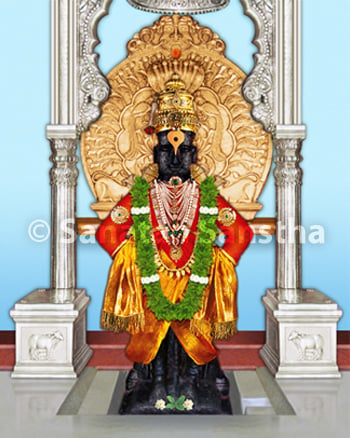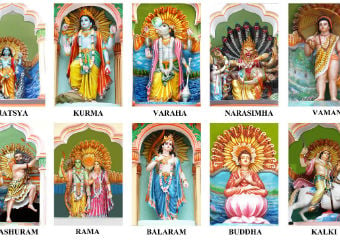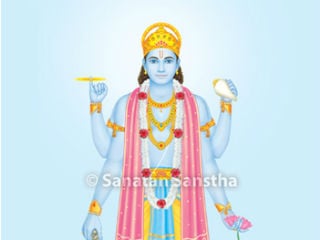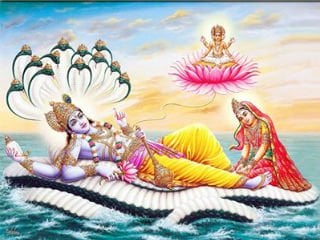Contents [hide]
This article provides details of forms of Shri Vishnu such as Vitthal and Vyankatesha and also explains characteristics of various members of His family.
1. Vitthal

A. Origin
- Dr. R.G. Bhandarkar says that the variation of the word ‘Vishnu’ in Kannada becomes ‘Bitti’ and Vitthal is derived from this variation.
- Late Vishnubuva Jog narrates the origin based on Saint Tukaram’s abhang (Devotional song) ‘Vichakelathoba as – ‘vi’ ‘vid’, meaning, to know or knowledge; ‘thoba’ means Idol. Thus Vithoba is a symbol of knowledge.
- According to the Arya-Prakrut language, the variation of Vishnu becomes Vitthu.
B. Pandurang
Pandurang is a Name of the fair-complexioned Shiva. In Kannada, this becomes Pandarange. Hence, Dr. Bhandarkar opines that the abode of Pandurang or Pandarange is Pandharpur.Many people wonder how He is named Pandurang (White)despite His Idol being dark-complexioned. Besides the point mentioned above, the answer is that to a true devotee His Idol appears white through the subtle-vision.Of the two Ekadashis in every Hindu lunar month, Vitthal is worshipped on the first Ekadashi and Pandurang on the second Ekadashi.
C. The consort (Divine Energy)
Rai and Rukmini are Vitthal’s consorts. Consorts of Deities are their Shaktis (Divine Energy). These are of two types – tarak (Saviour) and marak (Destroyer). From among Creation, Sustenance and Dissolution, Vitthal is the Deity of Sustenance; hence, both His Shaktis (Consorts) are associated with Creation and Sustenance.
- Rai : Rai is a particle of soil. It represents the potential of earth for procreation. (‘Shirish’ is the flower borne by ‘rai’ [Mustard] plant.) Rai is also known as Padmavati or Padubai. Padmakosha means the uterus.
- Rukmini (Rakhumai) : Rukmini means the form of a snake hole or shape of a conch. It also represents the uterus.
D. Science of the Idol
Vitthal’s Idol is dark-complexioned,has protruding eyes and stands on a brick with the hands held at the waist. When Pundalik served his parents, Deity Vitthal was pleased and appeared before him. At that time, to avoid any slip in service of his parents, Pundalik threw a brick towards Vitthal and asked Him to stand on it. The Deity stood watching His devotee’s service with admiration. This Idol is different from the Idols of other Deities which wield either a weapon or bless with one hand. It depicts Vitthal, who sees everything with the stance of a spectator.Sense organs are above the waist and motor organs below the waist. Hands on the waist mean One who has control over His motor organs.
2. Vyankatesha (Balaji)
Vyankatesha has several Names – Vyankoba, Venkatraman, Venkatadhvari, Venkatadri, Shrinivas,Balaji, etc. Another Name is Tirupati. ‘Tiru’ means ‘Shri’, and hence,Tirupati means Shripati Vishnu. Since the radiance of Balaji of Tirupati cannot be easily tolerated, His eyes are half-closed.Shri Lakshmi is not beside Vyankatesha. Her temple is situated below the mountain in the Tiruchanur village. Here, She is called Padmavati or Almelumang. Padmavati is called Padubai by the shepherds.
3. The consort
The main Shakti of Shri Vishnu – Shri Lakshmi. Some Incarnations that Shri Lakshmi assumed when Shri Vishnu incarnated are given ahead.
| Incarnation of Shri Vishnu | Incarnation of Shri Lakshmi |
|---|---|
| 1. Vaman | Kamalasambhav Lakshmi |
| 2. Parashuram | Bhumi (Earth) |
| 3. Shriram | Seeta |
| 4. Shrikrushna | Rukmini |
Shri Lakshmi is seated at the feet of Shri Vishnu because He holds His devotees close to His bosom and not ShriLakshmi ! Shri Lakshmi looks after the spiritual and worldly needs of Shri Vishnu’s devotees (or rather Shri Vishnu Himself does so using Her as a medium).
4. Narad
A. Origin and meaning
‘नारंददातिइति।’ – One who imparts nar, meaning, knowledge
B. Birth
He was born in space before the other Deities. Heis the son of Deity Brahma.
C. Physical characteristics
- A Shendi(tuft of hair) on the head.
- A musical instrument called the veena around His neck. With the pull of veena strings, particles of nourishment are generated. These are collected by Shri Vishnu. The Vaishnav sect believes that the universe was created from the sound of the veena. The Shaiva sect believes that the same happened by the sound generated through Shiva’s damaru.
- Always wandering in the three regions.
- He can wander anywhere in the universe, from the region of Deities to the region of demons, meaning, from the Heaven to Hell by the Vishnumarga any time within a fraction of a second.
D. Psychological characteristics
- Humorous nature.
- Instigates others, but conducive to the Divine mission and to reduce defects (such as ego) in others.
E. Spiritual characteristics
- Constantly chanting the Name ‘Narayan’.
- Constantly in communion with Shri Vishnu.
- He is Shri Vishnu’s inner disciple, meaning, one who has merged with Shri Vishnu’s inner self.
F. Mission
- Guidance to seekers.
- Conducive to the Divine mission; hence, He is also called as Devarshi (Sage of Gods). Narad is the son of Deity Brahma. Brahman means worthy of spiritual experience. Narad gets spiritual experiences and gives spiritual experiences to others too; hence, He is known as Mahamuni (A great Sage). The one who speaks only on Spirituality, is a Sage.
- Getting rid of defects such as ego in others.
- Composition of Holy texts : The Naradbhaktisutras, Naradpurana, Naradsanhita and Naradpancharatra have been written by Him.
5. Tumbaru
He is the son of Kashyap and Pracha. Some of His characteristics are given ahead.
- He is a Gandharva (Celestial musician).
- He has the countenance of a horse.
- He is the master of the two Hindu lunar months – Madhu and Madhav (Chaitra and Vaishakha). In the month of Chaitra, He accompanies Deity Sun in His chariot.
- The main singer in the Royal court of Deities Indra and Kuber.
- Player of the veena : The name of the veena is Kalavati.
- The tanpura has acquired its name from Him.
- On special occasions He also visits the earth.
- His wife is Rambha and His daughters Manovati&Sukesha.
6. Garuda
The Garuda (Eagle) has acquired great importance in the Vaishnav sect. It is considered a major Deity in the Vaishnav family. Just as Nandi (The bull) is present in front of Shiva, Garuda is present in front of Shri Vishnu. In many temples of Shri Vishnu, a special pillar is erected which is called ‘Garuda’ pillar. This Idol of Garuda in front of Shri Vishnu is usually made of black stone; it is rarely made of wood. The Idol has a human form but a beak and wings of a bird. It stands in a posture with the hands folded in obeisance. When Garuda has four arms, it is called Vainateya.
A. Garudavidya
In Sanskrut literature there is a science called sarpavidya, meaning, the science of snakes. It is also known as Vishavidya, meaning, the science of poisons. (ShriShankaracharyahas named it Garudavidya (or Garudavidya), meaning,science of Garuda. Sarpavidya is an art of subduing snakes.Garuda is the Deity of this science.’ An individual who practices Garudavidya is called garudi.
B. Garudagayatri
The worship of Garuda has been going on since the ancient times. Garudagayatri has been described in the Mahanarayanopanishad (3.15) as –
तत्पुरुषायविद्महे।सुवर्णपक्षायधीमहि।तन्नोगरुडःप्रचोदयात्।
Meaning : We are familiar with the Absolute Being in the form of an eagle. We meditate on that golden-winged Garuda. May he inspire our intellect benevolently.
C. Twelve names of Garuda and the benefits obtained by their daily recitation
In the Holy text Bruhadtantrasar, 12 Names of Garuda are prevalent. These are – 1. Suparna (With beautiful wings), 2.Vainateya (Son of Vinata), 3.Nagari (Enemy of snakes),4.Nagabhishan (One who is ruthless on snakes), 5.Jitantak (Onewho has won over time), 6.Vishari (Enemy of poison), 7.Ajit(One who never loses), 8.Vishwarupi (That which pervades the universe), 9. Gurutman (Extremely brave), 10.Khagashreshtha(Supreme among the birds), 11.Taksharya (Garuda) and 12.Kashyapnandan (Son of MaharshiKashyap).
Whoever gets up early and recites these 12 names everyday while bathing or going to bed, benefits in ways mentioned ahead.
- He is not affected by any type of poison.
- No wild animal can kill him.
- He is always victorious in war and business.
- He gets rewarded adequately for pilgrimages he undertakes.
- He has the capacity to attain Moksha (Final liberation).
7. Jay-Vijay
Once these two had a quarrel over dividing the southern portion. At that time, Jay cursed Vijay saying, “You will become a crocodile”. Vijay retaliated and cursed Jay, “You will become an elephant”. Later, both repented for what they had done and surrendered to Shri Vishnu, who promised them that He would uplift them after they had undergone the curses. Under the influence of the curses, they were born on the banks of the River Gandki, one as a crocodile and the other as an elephant. Once, in the Hindu lunar month of Kartik, when the elephant entered the river to bathe, the crocodile held its leg. The elephant then fervently prayed to Shri Vishnu for deliverance. Shri Vishnu manifested,released both of them from the bondages of the curses and took them to Vishnulok (Abode of Shri Vishnu).
Once, when Sage Sanak was visiting Shri Vishnu along with other Sages, Jay and Vijay stopped them. As a result, the Sages cursed them – ‘You two will be born as demons’. When they pleaded for mitigation of the curse, the Sages replied, ‘After three births you will be liberated and return to Vaikuntha’. To undergo this curse,Jay and Vijay were born as Hiranyaksha and Hiranyakashyapu, Ravan and Kumbhakarna, Shishupal and Vakradanta. Each time they were slain by one of Shri Vishnu’s Incarnations, and finally after three births, they returned to Vaikuntha.
8. Vishnudoot
Like Yama,the Deity of death, Shri Vishnu too has messengers. They protect the devotees of Shri Vishnu, and after their death, take them to Vishnulok. These messengers always reside in Vaikuntha. They too hold a conch, a chakra and a mace like Shri Vishnu does. The fourth hand holds a baton. A necklace of tulsi leaves adorns their neck. Even Deity Yama respects them.
9. Shaligram
It is a sacred stone, a symbol of Shri Vishnu. Situated 300 miles from Pashupatinathin Nepal is a place called Muktanath.Shaligrams are found there in River Gandaki. Besides, there is also a mountain of these stones. Idols are sculpted from these stones. It is also customary to carve yantras on these. The genuineness of these stones is tested based on certain types of chakras and openings on them. Sometimes, a stone may have a fine gold line on it. A genuine Shaligram is always heavier than a common stone, because it is non-porous like marble. As a result, it erodes less.
The colour of a Shaligram varies. Its name is derived from its colour – 1. Shubhra (White) – Vasudev, 2. Blue – Hiranyagarbha,3. Black – Shri Vishnu, 4. Red – Pradyumna, 5. Dark green – Shri Narayan and 6.Dark blue – Nrusimha or Vaman. A Shaligram with twelve circles on it is called Ananta.
Eighty-nine such varieties of a Shaligram are known as of now. Shaligram is kept either in milk or rice. Thereafter, if it increases in form and weight then it is considered suitable for regular ritualistic worship. In some temples of Shri Vishnu in South Bharat, a necklace of Shaligram adorns the neck of the Idol.

 The ten Incarnations of Shri Vishnu
The ten Incarnations of Shri Vishnu Science of the idol of Shri Vishnu
Science of the idol of Shri Vishnu Mission and Special Characteristics of Shri Vishnu
Mission and Special Characteristics of Shri Vishnu Vaikunth chaturdashi is an invaluable opportunity granted to us to worship Deity Shri Vishnu
Vaikunth chaturdashi is an invaluable opportunity granted to us to worship Deity Shri Vishnu Why a specific Name of Shri Vishnu is used for a specific task ?
Why a specific Name of Shri Vishnu is used for a specific task ?